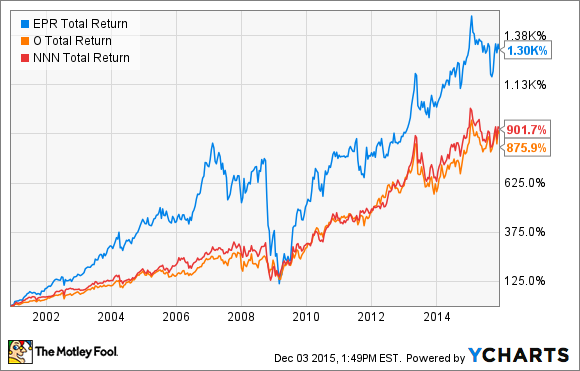
Source: Flickr user dallashangerphoto
Real estate investment trusts, or REITs, can be an excellent way to get large dividends and upside potential at the same time. One that is particularly interesting right now is EPR Properties (EPR +1.41%), a specialized but diverse REIT that aims to capitalize on several promising trends. Here's what you need to know about this unique REIT and why it could be a smart addition to your portfolio.
About EPR Properties
EPR Properties has been around since 1997, and has grown to hold 262 properties in 39 states, D.C., and Canada.
What makes EPR so unique is its investment strategy. Most REITs specialize in a single, broad property type, such as apartment buildings, healthcare facilities, or shopping malls. EPR, however, specializes in three specific, but different property types.
The largest focus of EPR is entertainment properties, which make up 54% of the portfolio, and consist of megaplex movie theaters, retail entertainment centers, and family entertainment complexes. Most of the rest of the portfolio is split between specific types of recreation properties -- ski parks, waterparks, and golf complexes -- and education properties such as public charter schools and early childhood education facilities.
The company uses a triple-net leasing structure under which tenants cover variable expenses such as taxes, insurance, and building maintenance. And, the portfolio is currently 99% leased -- an extremely impressive occupancy rate.
What's so appealing about these three property types?
These three property types all have some favorable trends working in their favor.
First, the megaplex movie theaters, which make up roughly half of the company's portfolio, are designed specifically to appeal to millennials, a group which represents 50% of moviegoers. With amenities such as premium quality seating and innovative in-theater food and beverage options, these "next generation" theaters are seeing double the customer spending of older ones. Plus, 2015 box office revenues are expected to set a new record.
Historically, box office revenue has grown at a steady rate of about 4% per year, which does not include company-specific food and beverage growth. In other words, EPR's tenants should experience rising revenue streams over the coming years, which can be expected to translate to strong tenant retention and the ability into steadily increase rents.

Source: EPR Company Presentation
The company's recreation properties also target a growing and profitable market. Its metropolitan ski resorts are close enough to major population areas that people can take day trips, allowing them to target those customers who don't want to travel to a ski destination. Its TopGolf golf entertainment complexes have been successful at targeting a new generation of golfers with indoor golf activities and food/beverage amenities. In fact, the brand's attendance grew by 48% in 2014 alone.
Finally, there are the education properties, which are perhaps the most appealing to long-term investors. Most of its education portfolio consists of 70 public charter schools, and this is an extremely attractive market where demand is growing faster than supply. The number of public charter schools has grown at an average 11% annual rate since 2000, but the number of students has grown even faster.

Source: EPR Company Presentation
Over 1,000,000 students are currently on waiting lists for public charter schools, and EPR sees this as a $2.5 billion potential opportunity. Early childhood education centers and private schools are relatively small portions of the portfolio, but EPR sees similar potential in these areas as well.
Responsible growth
EPR Properties' investment portfolio has grown rapidly, with total investments up by 172% over the past decade alone. The company is showing no signs of slowing down -- in fact, the investment total for 2015 is expected to be EPR's highest yet at $575 million to $625 million, and management expects 2016 to be bigger still.

Source: EPR Company Presentation
Despite the rapid growth, EPR's management is committed to growing responsibly. The company's debt-to-capital ratio stands at a conservative 37%, and is expected to stay in the 35% to 45% range for the foreseeable future.
To put this level of debt in perspective, consider that EPR has an interest coverage ratio of 3.7-to-1, meaning that for every $3.70 the company earns, just $1 goes toward paying interest on its debts.
The proof is in the performance
All of this sounds good in principle, but let's take a look at how EPR's investment strategy has translated into real-world results.
In a nutshell -- the performance has been fantastic. Since its IPO, the company has produced 2.5 times the returns of the MSCI U.S. REIT index, and has beaten most other major REITs over long periods of time -- including sector heavyweights Realty Income (O +0.47%) and National Retail Properties (NNN +0.87%).
As far as the dividend goes, EPR yields an impressive 6.6%, and has increased its payout by an average of 7% annually since 2010. In all, EPR has averaged a 17.6% total return over the past 15 years -- a remarkable level of performance over such a long time period. In comparison, Realty Income and National Retail Properties have averaged 15.4% and 15.2%, respectively. Don't get me wrong -- these are also impressive levels of performance, but as you can see, a couple of percentage points a year makes quite a difference over the long run.
EPR looks pretty cheap right now
According to EPR, the company expects adjusted funds from operations (AFFO) of $4.41 to $4.46 per share for 2015 (think of AFFO as the REIT version of "earnings"). As of this writing, this translates to a P/AFFO ratio of 12.4, which sound pretty cheap -- especially for a stock with a long history of double-digit returns.
Here's a look at how this compares to some of EPR's REIT peers.
|
REIT |
Symbol |
Share price (as of 12/3/15) |
2015 AFFO Guidance |
Price/AFFO (based on midpoint of guidance) |
|---|---|---|---|---|
|
EPR Properties |
EPR |
$55.18 |
$4.41-$4.46 |
12.4 |
|
Realty Income |
O |
$48.80 |
$2.72-$2.74 |
17.9 |
|
National Retail Properties |
NNN |
$37.95 |
$2.25-$2.28 |
16.8 |
As you can see, EPR is considerably "cheaper" than these sector-leading REITs. However, there may be a good reason for this.
A risk to be aware of
No stock with the potential for double-digit returns that trades for such a low valuation multiple is without risk, and EPR is no exception.
Specifically, a big reason why EPR is riskier than either of the REITs mentioned above is its reliance on discretionary spending. About three-fourths of the portfolio is made up of entertainment and recreational properties, which are extremely vulnerable to changes in consumers' ability and willingness to spend money. As you can see in the performance chart above, even though EPR delivered the best long-term performance, it was hit much harder than the others during the 2008-2009 recession.
Granted, the education portion of the portfolio has grown substantially since then, which somewhat mitigates this risk, but the fact remains that EPR's portfolio is not recession-proof. In contrast, Realty Income and National Retail Properties' portfolios are made up of properties that tend to perform well no matter how the economy is doing -- mainly occupied by retailers that sell non-discretionary goods, provide a service, or sell goods at low price points.
The Foolish bottom line
While it's not the biggest or best-known REIT, EPR is a unique specialized (but diversified) REIT. While past performance isn't a guarantee of future investment results, the trends are definitely favorable for EPR's properties, and there is little reason to believe its exceptional performance won't continue for years to come.









